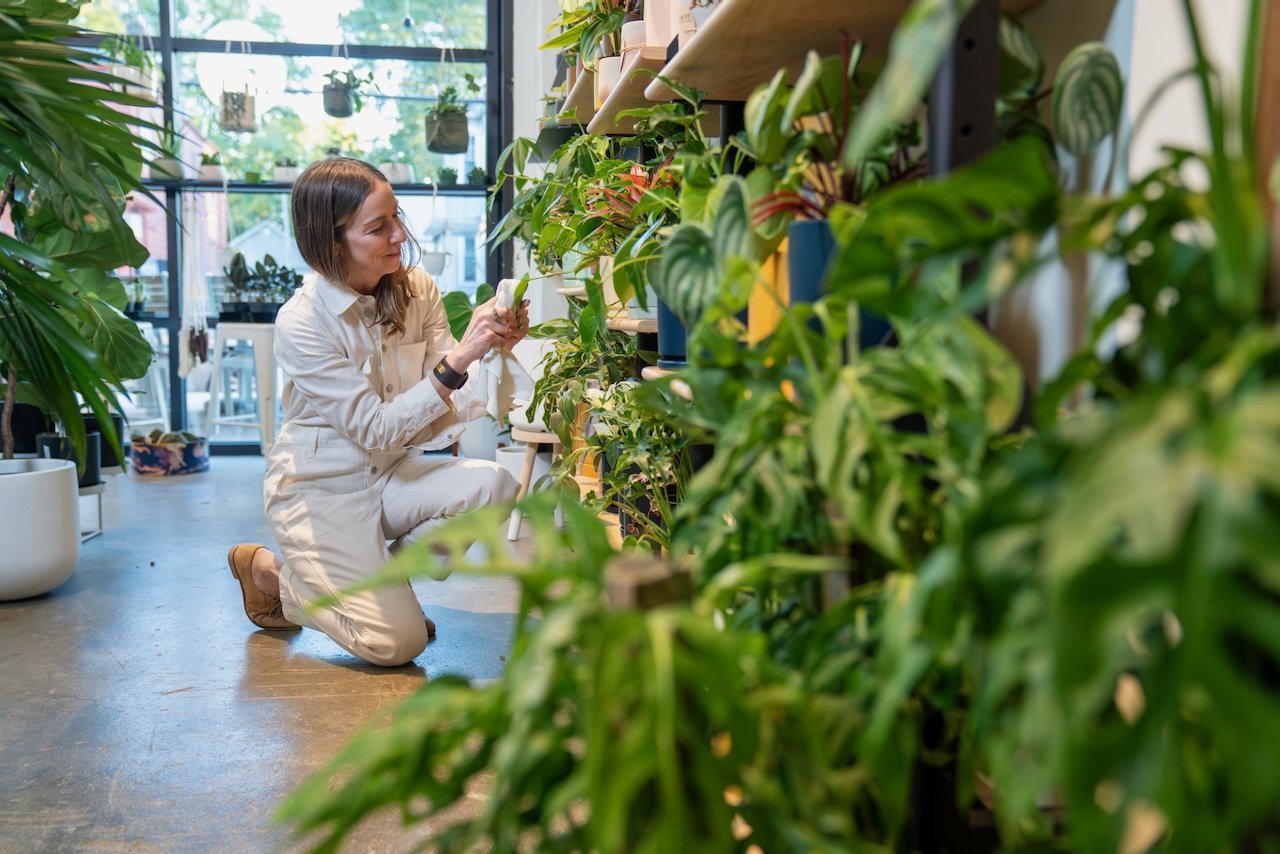What is your plant’s natural habitat?
Does your plant come from the desert where conditions are dry and sunny? Or, are they tropical, jungle plants that crave humidity? Or maybe they thrive on the forest floor under dappled sun? Envision where your plant naturally grows to help understand what it likes. High humidity plants do well in kitchens and bathrooms with good sunlight. Cacti and succulents do great in south and west facing windows with lots of sun.
SUNLIGHT
The direction your window faces impacts the kind of light and amount of light your plant receives each day.
East facing: A few hours of gentle morning sunlight
West facing: Afternoon sunlight, more intense than east facing
South facing: The most intense bright sunlight throughout the day
North facing: Least bright, colder, more diffused sunlight for much of the day
Choose a species likely to prosper in the light conditions your space has. If your space cannot provide the sunlight that your plant needs, consider a grow light.
The amount of light can also be impacted by nearby buildings and trees outside your windows and/or curtains/blinds that may block some light.
WATERING
Generally, the best method is to direct the spout of your watering can at the base of the plant and evenly saturate the surface of the potting medium. Let the water sink in. Then water it until the water comes out of the drainage holes at the bottom of the pot. If you water your plant just a little, their roots will not acquire enough moisture. Deep watering also reduces salt build up.
To avoid rotting roots, after watering it’s very important to make sure your plant is fully drained and not sitting in excess water in their cachepot or saucer.
Just like sunlight, the frequency that you water your plant depends on the particular preference of your plant. We recommend testing the soil with your finger. Dig down a few inches to determine whether to water your plant.
Most plants like to dry out a few inches before you water them. That means when you dig your finger in, the surface of the soil is crumbly to the touch and totally dry 2” to 3” down.
If your plant likes to dry out completely, poke your finger through the bottom drainage hole to test it. If it is dry and crumbly, water that baby.
Some plants want to stay moist. But no plant wants consistently soggy soil. Moist soil feels slightly damp and cool to the touch. If you press your finger into the soil and it is squishy like a very wet sponge, hold off on watering. Recheck in a day or two rather than risk overwatering.
Fluoride in tap water can damage sensitive plants (cause brown tips). It helps to leave your water out overnight so that some of the chemicals can evaporate. Or you can use distilled, filtered, or rainwater.
Room temperature water is best.
JEANNE’S TIP: Ease up a bit on your watering during the short days of winter (mid November to mid March). This is especially important for plants such as desert cacti and succulents.
POTTING & SOIL
Match your plant with the right potting mixture and the best pot.
If your plant likes to dry out, pick a gritty, rocky succulent/cactus mix. Otherwise, pick a light, aerated and chunky aroid mix.
In terms of pots, a ceramic pot with a saucer is a great option for your slower growing or mature plants that are not going to outgrow their pot any time soon.
Terracotta pots (with drainage holes) are great for plants that like to dry out.
Or choose a decorative cachepot to hold a nursery pot with holes/drainage. This is a great option for very large floor plants as well as fast-growing plants that you plan to “pot up” regularly.
What’s “potting up” and when should you do it?
When the roots are growing outside the bottom of the pot, that is a good sign it is time to “pot up” your plant. Potting up gives your plant a bigger vessel to grow in as well as fresh soil. Choose a new pot that is no more than 1”-2” wider and deeper than the old pot.
Squeeze the base of the pot (if it is plastic) or you can also use a chopstick around the rim of the pot to help loosen the plant from the pot. Turn the pot upside down and tap the bottom to release the plant (like you're burping a baby). Once your plant is free, gently remove old soil from the roots with your fingers (or a chopstick). Inspect the roots. They should be white or light tan, supple, not mushy. Fill the new pot halfway with fresh potting mix and place the plant inside. Add more mix until it reaches the same same height on your plant as it was in the last container. Tamp the soil down firmly to gently secure your plant in their new home. It’s not unusual for a plant to act a little stressed after repotting. It’s a little traumatic for them. So expect that they might need a little time readjusting to their new normal.
JEANNE’S TIP: Some plants, especially many flowering plants (such as Hoyas) don’t mind having their roots snug in a pot.
BEYOND THE BASICS
Rotate: Most plants will grow towards the sun. Rotating weekly helps with even growth.
Dust Leaves: When the leaves are dusty, your plant is not getting as much sunlight. Also they look prettiest when they are clean and glossy. Use a moist cloth and gently wipe the tops of the leaves. Support their underside with your other hand. They will love you for it.
Fertilize: Fertilize when you see new growth is starting. Never apply fertilizer to dry soil. Water your plant first! Follow the instructions from the manufacturer. In general though, too little fertilizer is better than too much.
Prune: Pruning can foster rapid development and prevent a lanky stem. Spring is the best time to prune. Take clean cuts above the node to encourage new growth. Trim moderately. Throughout the year, remove yellow, brown, dying leaves to keep your plant directing energy to healthy growth.
Know whether your plant is toxic to pets and children. Check the ASPCA website.
Recommended Tools:
Watering Can: Choose one with a narrow spout to ensure the best control.
Chopsticks: Great for helping remove clumps of dirt from roots when you are potting up.
Snips: Cut off dying segments of plants or use to trim a plant back and/or propagate.
Potting Tray: Makes clean up easy when repotting.
Mister: Increasing humidity and helps with dusty leaf cleaning.
GIFT CARDS
We offer gift cards in any amount from $10 to $500 and they can be used at our botany shop or cocktail bar.
WE’RE HERE
FOR YOU!
If you would like a deeper dive into plant care, let us know. We offer small group demos on a variety of topics and guided DIY lessons for plant parents of all levels.


